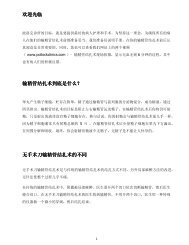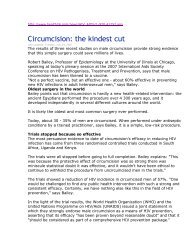You also want an ePaper? Increase the reach of your titles
YUMPU automatically turns print PDFs into web optimized ePapers that Google loves.
After 7 days<br />
At 2 months<br />
- Ease back into your usual activities.<br />
- It is safe to resume exercise, heavier work and lifting, but increase gradually over<br />
many days to pre-vasectomy levels.<br />
- Wear the scrotal support any time you work out or exercise over the next month.<br />
- Sexual activity can be resumed if you are not too sore. However, it is absolutely<br />
essential that you continue your prior method of birth control until your sperm can<br />
be flushed from the vas deferens tubes. This can take several months.<br />
- After you’ve abstained from ejaculating in the first week, you may notice in subsequent<br />
ejaculations a small amount of blood. This is normal.<br />
- Follow up with your semen specimen for analysis as described on page 10.<br />
Continue to use other methods of birth control until you have discussed your semen<br />
test results with Dr. <strong>Pollock</strong> and have been told that you can stop using your current<br />
birth control method.<br />
- After your second test (one month after your first test), call our office to schedule an<br />
appointment with Dr. <strong>Pollock</strong> to discuss both tests. You do not need to call us after<br />
your first test, we will just tell you to have the second test, then come in.<br />
While most men have no problems after their vasectomy, some minor discomforts that can<br />
occur include:<br />
- Black and blue marks on the scrotal skin<br />
- Swelling beneath the wound<br />
- Tenderness around the surgical site or the testicles<br />
- Discharge from the edge of the skin puncture<br />
- Sometimes small lumps form about the divided vas ends and may persist as small<br />
masses in the upper scrotum. This is healing tissue and may persist for a few months.<br />
If you note any of the above but it is getting better and not worse, do not worry about it. On the<br />
other hand, if it is not improving or getting worse, contact Dr. <strong>Pollock</strong> at 604.644.5775 and set<br />
up an appointment to be assessed as soon as possible.<br />
Call Dr. <strong>Pollock</strong>’s emergency cell phone number 604.644.5775 immediately if you:<br />
- Feel worrisome pain<br />
- Experience any worrisome swelling<br />
- Develop a fever<br />
-8-






